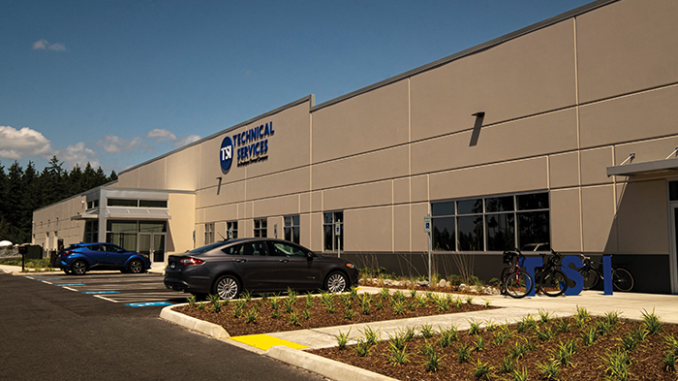
By / Jessica Kirby
Photos courtesy of ACCO Engineered Systems, Inc.
TSI (Technical Services Incorporated) has a brand new circuit board manufacturing facility in Oak Harbor, Washington, with state of the art mechanical and plumbing systems thanks to ACCO Engineered Systems, Inc. The 100,000-square-foot concrete tilt-up building includes administration offices, a loading dock, and an 80,000 sq ft. production area for maximum efficiency and innovation. Most importantly, it brings an entirely fresh level of heat and air management to a business that has been operating in a dated building with inadequate ventilation for over four decades.
The 200 x 500 foot ground-up construction project replaces TSI’s previous facility, founded in the 1970s on the adjacent property. That facility began as a single metal warehouse- style building, and over the years the owners expanded with additional metal buildings until the facility was a tangle of additions.
“They had no air-conditioning and a great deal of excess heat,” says Lisa Connors, PE, project manager for ACCO Engineered Systems, Inc., mechanical contractor for the project. “The summer time temperature measured 110 degrees F, and in the middle of winter it would get up to 85 degrees F with the doors open. They finally decided they could no longer operate that way.”
Heat is generated by four large reflow ovens where the circuit boards are baked and cured, and which run at 300-450 degrees F. “We had the huge task of how to control the heat and make the environment safe and comfortable,” Connors says. “Some of the ovens weren’t working correctly because they didn’t have the correct airflow through the unit.”
The ACCO team isolated the ovens in a hot room where each unit has a dedicated exhaust fan balanced correctly for the unit’s capacity and output. Most of the heat was generated from exhaust, given the units were not insulated and were acting like giant thermal radiators.
“You are talking 300 degree F air coming off of these and into the vertical ducts,” Connors says. “We insulated all the ducts coming off of the ovens and then PVC jacketed them to ten feet off the ground to ensure personnel protection and longevity of the insulation.”
The team installed high temperature exhaust fans so they were protected from the heat, and they added air-conditioning to the space. Depending on production, the ovens can all be turned on at once or turn off and on at different times, creating a large dynamicity heating load and make-up requirement. The system involves a single zone air handler with VAV controls and building pressure controls, and the air handler monitors the room and adjusts the outside air as needed for the space. The system also includes seven exhaust fans ranging from 2000 to 3000 CFM each.
Oak Harbor City has noise ordinance applied on sound not from the inside going out but from the outside penetrating the building. “There is a Navy base and Navy jets flying overhead for hours at a time,” Connors says. “That means the noise coming into the building is a big problem because it affects employees while they work.”
As a result, the building had strict requirements for double elbows on everything at first penetration, and these had to be lined. “We couldn’t have taps within so many feet within the first elbows, so the challenge was getting the equipment to look right without making the sound traps visible.”
The existing exhaust system was inadequate because it comprised stationary units that functioned like oversized vacuums at the end of 50 or 60 workbenches. “These scrubbers took the air from the space, cleaned it, and exhausted it back into the building, but we needed to get that air out of the building because it was that system was not efficient or effective,” Connors says.
ACCO installed dedicated exhaust systems at each station comprising fans and an innovative, embedded design that hid them in each table so the view from the facility is not obstructed.
The company’s labor force was kept low at five because the size of the space meant all trades could stagger their work by area and move collectively in a pattern, optimizing the schedule.
“We started at the north end of the building and worked south, and by the time we reached the south end the flow was set up and everyone, even the general contractor, was part of it,” Connors says. “The owner had a drop dead move in date of January 1, and although we started three months late we finished in December.”
Learn more about ACCO Engineered Systems, Inc. at accoes. com. ▪
